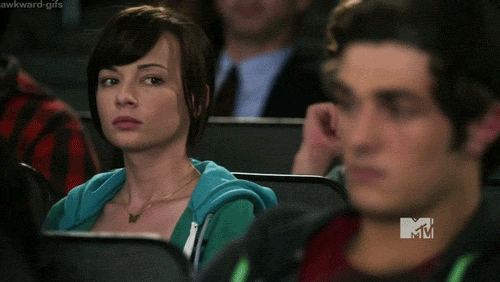The powerful effects of other's gaze have long been thought to arise from the unique power of others' eyes, but our work argues otherwise: The eyes are special only insofar as they signal deeper properties about the minds behind them — namely the nature and direction of others’ attention and intentions. In this way, eye contact might be better characterized as but one instance of a more general phenomenon of 'mind contact'.
More broadly, our work suggests that visual perception may extract not only physical attributes, but also mental states – such that we can 'perceive perception', and 'attend to attention'. We have explored these possibilities using two complementary approaches: click below to learn more!

Ashley Rickards getting caught staring at Beau Mirchoff in MTV's Awkward
Sample publications:
Colombatto, C., Chen, Y. -C., & Scholl, B. J. (2020). Gaze deflection reveals how gaze cueing is tuned to extract the mind behind the eyes. Proceedings of the National Academy of Sciences, 117, 19825-19829. [pdf] [demo] [supplement]
Colombatto, C., & Scholl, B. J. (2022). Unconscious pupillometry: An effect of ‘attentional contagion’ in the absence of visual awareness. Journal of Experimental Psychology: General, 151, 302-308. [pdf] [data] [pre-registrations]
Colombatto, C., Chen, Y. -C., & Scholl, B. J. (in press). Perceived gaze dynamics in social interactions can alter (and even reverse) the perceived temporal order of events. Cognition, 247, Article 105745, 1-8.
[pdf]
[pre-registrations]
[demos]
Colombatto, C., & Scholl, B. J. (in preparation). Attending to attention: Reverse correlation reveals how we perceive attentiveness in other people’s faces.
Colombatto, C., McCrackin, S. D., Scholl, B. J., & Ristic, J. (in preparation). Pupil dilation widens the perceived cone of direct gaze.

Andy Goldsworthy's "Hole covered with small pointed rocks" (Clapham, Yorkshire; January 1980)
In a series of experiments, we demonstrate that the effects of direct gaze arise even without eyes, as long as an agent's directed attention is conveyed by other means. For example, we have recently shown that the ‘stare-in-the-crowd’ effect, wherein faces are detected more readily when they look directly toward you, also arises with simple geometric shapes when they are seen as directed at the observer.
Sample publications:
Colombatto, C., van Buren, B., & Scholl, B. J. (2021). Hidden intentions: Visual awareness prioritizes perceived attention even without eyes or faces. Cognition, 217, Article 104901, 1-7. [pdf]
Colombatto, C., van Buren, B., & Scholl, B. J. (2020). Gazing without eyes: A 'stare-in-the-crowd' effect induced by simple geometric shapes. Perception, 49, 782-792. [pdf]
Colombatto, C., van Buren, B., & Scholl, B. J. (2019). Intentionally distracting: Working memory is disrupted by the perception of other agents attending to you -- even without eye-gaze cues. Psychonomic Bulletin & Review, 26, 951-957. [pdf]
If any old picture is worth a thousand words, then pictures of faces may be worth considerably more than that: when looking at someone, we rapidly and effortlessly extract a variety of properties, from basic demography to complex personality traits.
Sample publications:
Colombatto, C., & McCarthy, G. (2017). The effects of face inversion and face race on the P100 ERP. Journal of Cognitive Neuroscience, 29, 664-676. [pdf]
Colombatto, C., Uddenberg, S., & Scholl, B. J. (2021). The efficiency of demography in face perception. Attention, Perception, & Psychophysics, 83, 3104–3117. [pdf] [pre-registrations] [supplement]
Colombatto, C., Crockett, M. J., & Scholl, B. J. (in preparation). ‘Perceptual ageism’: Distinct trajectories of first impressions from faces across their lifespan.
To effectively communicate and collaborate with others, we must monitor not only other people’s cognitive states (e.g., what someone thinks or believes), but also their metacognitive states (e.g., how confident they are in their beliefs). In recent work, we have started exploring the perception of these second-order states such as awareness, confidence, or uncertainty — and how such impressions facilitate communication and collaboration with both humans and non-biological agents.
Sample publications:
Colombatto, C., & Fleming, S. M. (under revision). Illusions of confidence in artificial systems.
[pdf]
[data & code]
Colombatto, C., & Fleming, S. M. (2024). Folk psychological attributions of consciousness to large language models. Neuroscience of Consciousness, 2024, niae013.
[pdf]
[data & code]
Colombatto, C., & Fleming, S. M. (in preparation). Metacognition as a key dimension in social perception.
I also work on several other projects exploring the visual roots of higher level processes such as social groups, moral judgment, and aesthetic experience.
Sample publications:
Colombatto, C., Capozzi, F., Fratino, V., & Ristic, J. (under revision). A perceptual advantage for social groups.
Colombatto, C., Conway, P., De Brigard, F., Hofmann, W., Sinnott-Armstrong, W., Stanley, M. L., Yu, H., & Crockett, M. J. (in preparation). Motivated abstraction of personal transgressions in moral narratives.
Colombatto, C., & Crockett, M. J. (in preparation). Immoral behavior generates higher disagreement in collective moral impressions.
Chen, Y. -C., Colombatto, C., & Scholl, B. J. (2018). Looking into the future: An inward bias in aesthetic experience driven only by gaze cues. Cognition, 176, 209-214. [pdf] [demo]